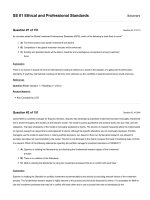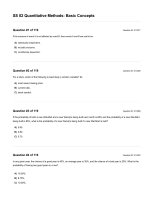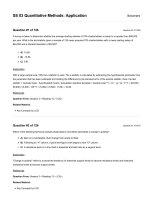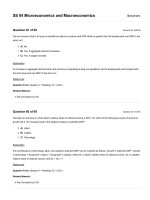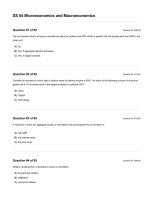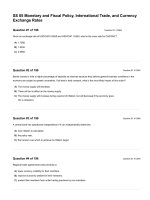CFA 2019 level 1 schwesernotes book quiz bank SS 05 answers
Bạn đang xem bản rút gọn của tài liệu. Xem và tải ngay bản đầy đủ của tài liệu tại đây (921.08 KB, 93 trang )
SS 05 Monetary and Fiscal Policy, International Trade, and Currency
Exchange Rates
Answers
Question #1 of 196
Question ID: 413964
Given an exchange rate of USD/CAD 0.9250 and USD/CHF 1.6250, what is the cross rate for CAD/CHF?
✓ A) 1.7568.
✗ B) 1.5032.
✗ C) 0.5692.
Explanation
(USD/CHF 1.6250) / (USD/CAD 0.9250) = CAD/CHF 1.7568
References
Question From: Session 5 > Reading 20 > LOS d
Related Material:
Key Concepts by LOS
Question #2 of 196
Question ID: 413842
Banks choose to hold a higher percentage of deposits as reserves because they believe general business conditions in the
economy are subject to greater uncertainty. If all else is held constant, what is the most likely impact of this action?
✓ A) The money supply will decrease.
✗ B) There will be no effect on the money supply.
✗ C) The money supply will increase during a period of inflation, but will decrease if the economy goes
into a recession.
Explanation
If banks choose to hold excess reserves, they will decrease their lending. Less bank lending will cause the money supply to
decrease.
References
Question From: Session 5 > Reading 18 > LOS c
Related Material:
Key Concepts by LOS
Question #3 of 196
Question ID: 413868
A central bank has operational independence if it can independently determine:
✗ A) how inflation is calculated.
✓ B) the policy rate.
✗ C) the horizon over which to achieve its inflation target.
Explanation
A central bank is said to have operational independence if it has the authority to determine the policy rate independently.
Determining how inflation is calculated and the time horizon for achieving its target rate of inflation refer to a central bank that has
target independence.
References
Question From: Session 5 > Reading 18 > LOS j
Related Material:
Key Concepts by LOS
Question #4 of 196
Question ID: 413934
Regional trade agreements exist primarily to:
✗ A) lower currency volatility for their members.
✓ B) improve economic welfare for their members.
✗ C) protect their members from unfair trading practices by non-members.
Explanation
The primary reason countries join regional trade agreements is to improve economic welfare by reducing or eliminating trade
restrictions.
References
Question From: Session 5 > Reading 19 > LOS f
Related Material:
Key Concepts by LOS
Question #5 of 196
Question ID: 413936
Which of the following lists of trading blocs is most accurately ordered by degree of economic integration, from least to most
integrated?
✗ A) Free trade area, common market, customs union.
✓ B) Customs union, economic union, monetary union.
✗ C) Free trade area, economic union, common market.
Explanation
The order by degree of economic integration (from least to most integrated) is as follows: free trade areas, customs union,
common market, economic union, and monetary union.
References
Question From: Session 5 > Reading 19 > LOS f
Related Material:
Key Concepts by LOS
Question #6 of 196
Question ID: 413851
Which of the following statements about the demand and supply of money is most accurate? People who are:
✗ A) holding money when interest rates are lower will try to increase their money balances and, as a result, the
supply of money increases.
✓ B) holding money when interest rates are higher will try to reduce their money balances and, as a result, the
demand for money decreases.
✗ C) buying bonds to reduce their money balances will increase the demand for bonds with an associated
increase in interest rates.
Explanation
Buying bonds would drive bond prices up and interest rates down. Selling bonds would have the opposite effect; driving bond prices down
and interest rates up. When interest rates are lower, there is an excess demand for money. The supply of money is determined by the
monetary authorities.
References
Question From: Session 5 > Reading 18 > LOS d
Related Material:
Key Concepts by LOS
Question #7 of 196
Question ID: 413900
The government budget deficit of Country M is increasing. At the same time, the government budget surplus of Country N is
decreasing. Are the fiscal policies of these countries expansionary or contractionary?
✓ A) Both are expansionary.
✗ B) Both are contractionary.
✗ C) One is expansionary and one is contractionary.
Explanation
Expansionary fiscal policy increases a budget deficit or decreases a budget surplus. Contractionary fiscal policy decreases a
budget deficit or increases a budget surplus.
References
Question From: Session 5 > Reading 18 > LOS s
Related Material:
Key Concepts by LOS
Question #8 of 196
Question ID: 413928
The primary benefits derived from tariffs usually accrue to:
✗ A) foreign producers of goods protected by tariffs.
✓ B) domestic suppliers of goods protected by tariffs.
✗ C) domestic producers of export goods.
Explanation
Tariffs raise domestic prices, benefiting domestic suppliers.
References
Question From: Session 5 > Reading 19 > LOS e
Related Material:
Key Concepts by LOS
Question #9 of 196
Question ID: 413952
An exchange rate at which two parties agree to trade a specific amount of one currency for another a year from today is called a:
✗ A) spot exchange rate.
✓ B) forward exchange rate.
✗ C) real exchange rate.
Explanation
A forward exchange rate specifies the amount of two currencies that will be exchanged at a specific point of time in the future. A
transaction that uses the spot exchange rate is one that would occur immediately. A real exchange rate is one that has been
adjusted for the relative inflation rates in two countries, and could be referring to an exchange rate that prevails at any given time.
References
Question From: Session 5 > Reading 20 > LOS a
Related Material:
Key Concepts by LOS
Question #10 of 196
Question ID: 434265
Country G and Country H have currencies that trade freely and have markets for forward currency contracts. If Country G has an
interest rate greater than that of Country H, the no-arbitrage forward G/H exchange rate is:
✓ A) greater than the G/H spot rate.
✗ B) less than the G/H spot rate.
✗ C) equal to the G/H spot rate.
Explanation
. If the interest rate in Country G is greater than the interest rate in Country H, the numerator is
greater than the denominator on the right side of the equation. The left side must have the same relationship, so the forward rate
must be greater than the spot rate.
References
Question From: Session 5 > Reading 20 > LOS f
Related Material:
Key Concepts by LOS
Question #11 of 196
Question ID: 413988
The tendency for currency depreciation to increase a country's trade deficit in the short run is known as the:
✗ A) absorption effect.
✗ B) Marshall-Lerner effect.
✓ C) J-curve effect.
Explanation
The J-curve refers to a graph of the effect of currency depreciation on the trade balance over time. In the short run, a trade deficit
may increase because current import and export contracts may be fixed in foreign currency units over the near term, and only
reflect the exchange rate change over time. In the long run, currency depreciation should decrease a trade deficit.
References
Question From: Session 5 > Reading 20 > LOS j
Related Material:
Key Concepts by LOS
Question #12 of 196
Question ID: 696228
The term "automatic stabilizers" refers to:
✗ A) changes in taxes and expenditure programs legislators automatically enact in response to changes
the level of economic activity in order to smooth economic cycles.
✗ B) government expenditures and tax receipts that are required to balance over the course of the
business cycle, although they may be out of balance in any single year.
✓ C) increases in transfer payments and decreases in tax revenues that result from an economic
contraction without new legislation.
Explanation
Automatic stabilizers refers the increase (decrease) in transfer payments such as unemployment compensation and the
decrease (increase) in tax revenue that result from a decrease (increase) in the level of economic activity. These effects tend to
move the fiscal budget toward a deficit when economic activity decreases and toward surplus when economic activity increases,
and tend to dampen economic cycles.
References
Question From: Session 5 > Reading 18 > LOS o
Related Material:
Key Concepts by LOS
Question #13 of 196
Which of the items below is NOT a valid reason why nations adopt trade restrictions? To:
✗ A) prohibit foreign firms from increasing market share by selling products below cost.
✓ B) protect industries in which they have a comparative advantage.
✗ C) protect industries that are highly sensitive to national security.
Explanation
If a particular country enjoys a comparative advantage in a particular industry, no protection is needed.
References
Question From: Session 5 > Reading 19 > LOS e
Question ID: 413923
Related Material:
Key Concepts by LOS
Question #14 of 196
Question ID: 434237
Promoting economic growth and price stability are the goals of:
✗ A) fiscal policy, but not monetary policy.
✗ B) monetary policy, but not fiscal policy.
✓ C) both fiscal and monetary policy.
Explanation
Both monetary and fiscal policies are used by policymakers with the goals of maintaining stable prices and producing positive
economic growth.
References
Question From: Session 5 > Reading 18 > LOS a
Related Material:
Key Concepts by LOS
Question #15 of 196
Question ID: 413965
Given the following quotes, GBP/USD 2.0000 and MXN/USD 8.0000, calculate the direct MXN/GBP spot cross exchange rate.
✓ A) 4.0000.
✗ B) 0.6250.
✗ C) 0.2500.
Explanation
Invert the first quote to read USD/GBP 0.5000. Then, 0.5000 × 8.0000 = 4.0000 MXN/GBP.
References
Question From: Session 5 > Reading 20 > LOS d
Related Material:
Key Concepts by LOS
Question #16 of 196
Question ID: 413973
If the AUD/CAD spot exchange rate is 0.9875 and 60-day forward points are −25, the 60-day AUD/CAD forward rate is closest to:
✗ A) 0.9900.
✓ B) 0.9850.
✗ C) 0.9870.
Explanation
For an exchange rate quoted to four decimal places, forward points are expressed in units of 0.0001. The 60-day forward rate is
0.9875 + 0.0001(−25) = 0.9850.
References
Question From: Session 5 > Reading 20 > LOS e
Related Material:
Key Concepts by LOS
Question #17 of 196
Question ID: 413896
Which of the following statements best explains the importance of the timing of changes in discretionary fiscal policy? Changes in
discretionary fiscal policy must be timed properly if they are going to:
✓ A) exert a stabilizing influence on an economy.
✗ B) enable the government to control the money supply.
✗ C) help the government achieve a balanced budget.
Explanation
Proper timing of discretional policy is needed to reduce economic instability. If timed incorrectly, the fiscal policy change could
increase rather than reduce economic instability.
References
Question From: Session 5 > Reading 18 > LOS r
Related Material:
Key Concepts by LOS
Question #18 of 196
The difference between Country D's nominal and real exchange rates with Country F is most closely related to:
Question ID: 434261
✓ A) the ratio of the two countries' price levels.
✗ B) the risk-free interest rates of the two countries.
✗ C) Country D's inflation rate.
Explanation
The difference between real exchange rates and nominal exchange rates is the relative inflation rates over time between the two
countries. Real exchange rate (D/F) = nominal exchange rate (D/F) ×
.
References
Question From: Session 5 > Reading 20 > LOS a
Related Material:
Key Concepts by LOS
Question #19 of 196
Question ID: 413931
In what way does a tariff differ from a quota? A tariff is:
✗ A) a tax imposed by a foreign government, whereas a quota is a limit on the total amount of trade
allowed.
✓ B) a tax imposed on imports, whereas a quota is a limit on the number of units of a good that can be
imported.
✗ C) not significantly different from a quota; tariffs are imposed by world organizations, whereas quotas
are imposed by individual countries.
Explanation
The difference between a tariff and a quota is that a tariff is a tax imposed on imported goods, while a quota is an import quantity
limitation. Also, a tariff will generate tax revenue, but a quota does not.
References
Question From: Session 5 > Reading 19 > LOS e
Related Material:
Key Concepts by LOS
Question #20 of 196
Question ID: 413968
If the spot exchange rate between the British pound and the U.S. dollar is GBP/USD 0.7775, and the spot exchange rate
between the Canadian dollar and the British pound is CAD/GBP 1.8325, what is the USD/CAD spot cross exchange rate?
✗ A) 0.42428.
✓ B) 0.70186.
✗ C) 1.42477.
Explanation
First, convert GBP/USD 0.7775 to 1/0.7775 = USD/GBP 1.28617.
Then, divide USD/GBP 1.28617 by CAD/GBP 1.8325 = USD/CAD 0.70187.
References
Question From: Session 5 > Reading 20 > LOS d
Related Material:
Key Concepts by LOS
Question #21 of 196
Question ID: 413921
In the Ricardian model of trade, the source of comparative advantage is:
✓ A) labor productivity.
✗ B) the difference between labor productivity and capital productivity.
✗ C) capital productivity.
Explanation
The Ricardian model of trade only considers labor as a factor of production. Comparative advantage results from differences in
labor productivity. Labor and capital inputs are both considered in the Heckscher-Ohlin model of trade.
References
Question From: Session 5 > Reading 19 > LOS d
Related Material:
Key Concepts by LOS
Question #22 of 196
Question ID: 413878
An economy's long-term trend rate of real GDP growth is 3% and the central bank's target inflation rate is 2%. If the policy rate is
6%, monetary policy is:
✗ A) expansionary.
✗ B) neutral.
✓ C) contractionary.
Explanation
Monetary policy is contractionary when the policy rate is greater than the neutral rate, which is the sum of the real trend rate of
economic growth and the target rate of inflation. Here, the neutral rate is 3% + 2% = 5% and the policy rate of 6% is greater than
the neutral rate. Monetary policy is expansionary when the policy rate is less than the neutral interest rate.
References
Question From: Session 5 > Reading 18 > LOS m
Related Material:
Key Concepts by LOS
Question #23 of 196
Question ID: 413914
The law of comparative advantage explains why a nation will benefit from trade when it:
✗ A) exports goods for which it is a high-cost producer, while importing those for which it is a low-cost
producer.
✓ B) exports goods for which it is a low-cost producer, while importing those for which it is a high-cost
producer.
✗ C) exports more than it imports.
Explanation
Comparative advantage is the ability to produce a good at a lower opportunity cost than others can produce it. When trading
partners specialize in producing products for which they have a comparative advantage; costs are minimized, output is greater,
and both trading partners benefit.
References
Question From: Session 5 > Reading 19 > LOS c
Related Material:
Key Concepts by LOS
Question #24 of 196
Question ID: 413855
The primary objective of a central bank is to:
✗ A) stabilize exchange rates.
✓ B) control inflation.
✗ C) achieve full employment.
Explanation
Although some central banks have other stated goals including stabilizing exchange rates and achieving full employment, the
primary objective for a central bank is to control inflation and promote price stability.
References
Question From: Session 5 > Reading 18 > LOS f
Related Material:
Key Concepts by LOS
Question #25 of 196
Question ID: 413891
The crowding-out model implies that a:
✗ A) budget surplus will retard aggregate demand and trigger an economic downturn.
✗ B) budget deficit will stimulate aggregate demand and trigger a multiplier effect which will lead to
inflation.
✓ C) budget deficit will increase the real interest rate and thereby retard private investment.
Explanation
Increased budget deficits will increase the demand for loanable funds and lead to higher interest rates and thus lower private
investment. Crowding-out implies that an increase in government spending will choke off private investment and reduce the
intended impact of fiscal policy changes on aggregate demand.
References
Question From: Session 5 > Reading 18 > LOS q
Related Material:
Key Concepts by LOS
Question #26 of 196
Question ID: 434257
Government-owned assets abroad and foreign-owned assets in the country are included in which of the balance of payments
accounts?
✓ A) Financial account.
✗ B) Capital account.
✗ C) Current account.
Explanation
Government-owned assets abroad and foreign-owned assets in the country are sub-accounts of the financial account.
References
Question From: Session 5 > Reading 19 > LOS h
Related Material:
Key Concepts by LOS
Question #27 of 196
Question ID: 434236
When the central bank reduces the quantity of money and credit in an economy, its monetary policy is best described as:
✗ A) accommodative.
✗ B) expansionary.
✓ C) contractionary.
Explanation
When the central bank is reducing the quantity of money and credit in an economy, the monetary policy is said to be
contractionary, restrictive, or tight.
References
Question From: Session 5 > Reading 18 > LOS a
Related Material:
Key Concepts by LOS
Question #28 of 196
Question ID: 413974
The spot CHF/EUR exchange rate is 1.2025. If the 90-day forward quotation is +0.25%, the 90-day forward rate is closest to:
✗ A) 1.2000.
✓ B) 1.2055.
✗ C) 1.2050.
Explanation
The 90-day forward CHF/EUR exchange rate is 1.2025 × 1.0025 = 1.20551. The EUR is at a forward premium to the CHF.
References
Question From: Session 5 > Reading 20 > LOS e
Related Material:
Key Concepts by LOS
Question #29 of 196
Question ID: 413862
If a monetary policy is focused on combating inflation, which open market actions by the Federal Reserve will most effectively
accomplish this?
✓ A) Sell Treasury securities, causing aggregate demand to decrease.
✗ B) Purchase Treasury securities, causing aggregate demand to decrease.
✗ C) Sell Treasury securities, causing aggregate demand to increase.
Explanation
If the Federal Reserve wants to slow inflation, it needs to decrease aggregate demand (i.e., business investment, consumer
purchases of durable goods, and exports). To accomplish this, the Federal Reserve could engage in open market sales of
Treasury securities.
References
Question From: Session 5 > Reading 18 > LOS h
Related Material:
Key Concepts by LOS
Question #30 of 196
Question ID: 413885
When an economy dips into a recession, automatic stabilizers will tend to alter government spending and taxation so as to:
✗ A) reduce the budget deficit (or increase the surplus).
✗ B) reduce interest rates, thus stimulating aggregate demand.
✓ C) enlarge the budget deficit (or reduce the surplus).
Explanation
During a recession unemployment is high, so the government will pay out more in unemployment compensation at the exact time that tax
receipts from corporations and individuals are low. This will increase the size of the deficit and also maintain aggregate demand during
recessionary periods.
References
Question From: Session 5 > Reading 18 > LOS o
Related Material:
Key Concepts by LOS
Question #31 of 196
In which of the following exchange rate regimes can a country participate without giving up its own currency?
Question ID: 413985
✗ A) Crawling peg or formal dollarization.
✗ B) Monetary union or currency board.
✓ C) Target zone or conventional fixed peg.
Explanation
With formal dollarization or a monetary union, a country does not have its own currency. With a currency board, conventional
fixed peg, target zone, or crawling peg, a country has its own currency and manages its exchange rate with another currency or
basket of currencies.
References
Question From: Session 5 > Reading 20 > LOS i
Related Material:
Key Concepts by LOS
Question #32 of 196
Question ID: 413845
Which of the following statements about the relationship between interest rates and the demand for and supply of money is most accurate?
Interest rates affect:
✓ A) the demand for money only.
✗ B) both the demand for and supply of money.
✗ C) the supply of money only.
Explanation
Interest rates only affect the demand for money. With higher interest rates, the opportunity cost of holding money increases, and people
hold less money and more interest-earning assets. Monetary authorities determine the supply of money. Therefore, the supply of money is
independent of the interest rate.
References
Question From: Session 5 > Reading 18 > LOS d
Related Material:
Key Concepts by LOS
Question #33 of 196
Policies that can be used as tools for redistribution of wealth and income include:
✗ A) both fiscal policy and monetary policy.
✓ B) fiscal policy only.
Question ID: 413829
✗ C) monetary policy only.
Explanation
Fiscal policy can be used as a tool for redistribution of income and wealth, through a variety of taxation and spending policies.
References
Question From: Session 5 > Reading 18 > LOS a
Related Material:
Key Concepts by LOS
Question #34 of 196
Question ID: 413848
Which of the following statements regarding money demand and supply is least accurate?
✗ A) The supply curve for money is vertical.
✓ B) As the Fed reduces the money supply, short-term interest rates decrease.
✗ C) The supply of money is determined by the monetary authority and is not affected by changes in interest
rates.
Explanation
As the Fed reduces the money supply, short-term interest rates increase. The other statements concerning the demand and supply for
money are true.
References
Question From: Session 5 > Reading 18 > LOS d
Related Material:
Key Concepts by LOS
Question #35 of 196
Question ID: 413972
The spot exchange rate is 1.1132 GBP/EUR and the 1-year forward rate is quoted as +1349 points. The 1-year forward
exchange rate for GBP/EUR is closest to:
✗ A) 1.2634.
✗ B) 1.1267.
✓ C) 1.2481.
Explanation
The one year forward is 1.1132 + (1349/10,000) = 1.2481.
References
Question From: Session 5 > Reading 20 > LOS e
Related Material:
Key Concepts by LOS
Question #36 of 196
Question ID: 413871
The open market sale of Treasury securities by the Federal Reserve is least likely to result in:
✓ A) increased exports of U.S. goods.
✗ B) a decreased rate of inflation.
✗ C) increased longer-term interest rates.
Explanation
When the Fed sells Treasuries, it causes both short- and long-term interest rates to increase. This rate increase causes the dollar
to appreciate, which reduces foreign demand for domestic goods, causing exports to decline. The interest rate increase also puts
downward pressure on price levels, which causes inflation to slow.
References
Question From: Session 5 > Reading 18 > LOS i
Related Material:
Key Concepts by LOS
Question #37 of 196
Question ID: 434249
If a country can produce a good at a lower opportunity cost relative to another country, it is said to have a(n):
✗ A) absolute advantage.
✓ B) comparative advantage.
✗ C) autarkian advantage.
Explanation
A country is said to have a comparative advantage in the production of a good if its opportunity cost, in terms of other goods that
could be produced instead, is lower than that of another country.
References
Question From: Session 5 > Reading 19 > LOS c
Related Material:
Key Concepts by LOS
Question #38 of 196
Question ID: 434247
Compared to not engaging in international trade, a country that engages in international trade is most likely to experience:
✗ A) higher prices for consumer goods.
✓ B) increased specialization of domestic industries.
✗ C) lower employment in exporting industries.
Explanation
International trade should result in greater specialization in domestic industries because production shifts to lines in which
domestic producers have a comparative advantage.
References
Question From: Session 5 > Reading 19 > LOS b
Related Material:
Key Concepts by LOS
Question #39 of 196
Question ID: 434263
In the foreign exchange markets, transactions by households and small institutions for tourism, cross-border investment, or
speculative trading comprise the:
✗ A) real money market.
✓ B) retail market.
✗ C) sovereign wealth market.
Explanation
The retail foreign exchange market refers to transactions by households and relatively small institutions and may be for tourism,
cross-border investment, or speculative trading.
References
Question From: Session 5 > Reading 20 > LOS b
Related Material:
Key Concepts by LOS
Question #40 of 196
Question ID: 413912
Suppose labor in Venezuela is less productive than labor in the United States in all areas of production. Which of the following statements
about trading between Venezuela and the U.S. is most accurate?
✗ A) Venezuela will not have a comparative advantage in any good.
✓ B) Both nations can benefit from trade.
✗ C) Venezuela can benefit from trade but the U.S. cannot.
Explanation
Although one country may have an absolute advantage in all areas, trade is based on differences in opportunity costs, or comparative
advantage. Any country will always have a comparative advantage in the production of some goods; thus, all countries can benefit from
trade.
References
Question From: Session 5 > Reading 19 > LOS c
Related Material:
Key Concepts by LOS
Question #41 of 196
Question ID: 413935
Which form of regional trading agreement is least likely to allow free movement of labor?
✓ A) Customs union.
✗ B) Economic union.
✗ C) Common market.
Explanation
Economic unions and common markets remove all barriers to the movement of labor and capital among their members. Customs
unions do not have this feature.
References
Question From: Session 5 > Reading 19 > LOS f
Related Material:
Key Concepts by LOS
Question #42 of 196
Question ID: 413937
The form of regional trading agreement (RTA) least likely to have the unintended negative effect of reducing a member country's
low-cost imports from a non-member country is a:
✗ A) common market.
✓ B) free trade area.
✗ C) customs union.
Explanation
A free trade area removes barriers to trade among its members but does not require any of its members to change their trade
policies with non-members. A common market and a customs union both impose uniformity on trade rules with non-member
nations, which could restrict a member's low-cost imports from a nation that is not a member.
References
Question From: Session 5 > Reading 19 > LOS f
Related Material:
Key Concepts by LOS
Question #43 of 196
Question ID: 413873
If the U.S. Federal Reserve decides to decrease the money supply, which of the following is most likely to occur in the short run?
✗ A) An increase in the velocity of money similar to decrease in the money supply.
✓ B) An increase in the real rate of interest.
✗ C) A decrease in the unemployment rate.
Explanation
If the U.S. Federal Reserve decreases the money supply, an increase in nominal and real interest rates will occur. Higher real
rates will cause businesses to invest less, which will cause the unemployment rate to increase. Furthermore, households will
decrease purchases of durable goods, automobiles, and other items that are typically financed at short-term rates. This will
decrease aggregate demand. The decrease in aggregate demand and expenditures will cause incomes to go down, which
further decreases consumption and investment. Moreover, this decrease in aggregate demand will decrease real GDP and the
price level in the short run and the long run.
References
Question From: Session 5 > Reading 18 > LOS i
Related Material:
Key Concepts by LOS
Question #44 of 196
Question ID: 413971
The spot exchange rate is 0.6243 USD/GBP and the 1-year forward rate is quoted as 3.016%. The 1-year forward exchange rate
for USD/GBP is closest to:
✓ A) 0.6431.
✗ B) 0.6544.
✗ C) 0.6054.
Explanation
The one year forward rate is 0.6243 × (1 + 0.03016) = 0.6431.
References
Question From: Session 5 > Reading 20 > LOS e
Related Material:
Key Concepts by LOS
Question #45 of 196
Question ID: 413940
Sales and purchases of non-produced, non-financial assets are included in which of a country's trade accounts?
✗ A) Current account.
✗ B) Financial account.
✓ C) Capital account.
Explanation
The capital account consists of sales and purchases of non-produced, non-financial assets plus capital transfers.
References
Question From: Session 5 > Reading 19 > LOS h
Related Material:
Key Concepts by LOS
Question #46 of 196
Question ID: 413901
Which of the following fiscal and monetary policy scenarios is most likely to increase the size of the public sector relative to the
private sector?
✓ A) Expansionary fiscal policy and contractionary monetary policy.
✗ B) Contractionary fiscal and monetary policy.
✗ C) Expansionary monetary policy and contractionary fiscal policy.
Explanation
Expansionary fiscal policy tends to expand the public sector. Contractionary monetary policy tends to contract the private sector.
References
Question From: Session 5 > Reading 18 > LOS t
Related Material:
Key Concepts by LOS
Question #47 of 196
Question ID: 413920
The source of comparative advantage in the Heckscher-Ohlin model of trade is differences among countries in:
✗ A) labor productivity.
✓ B) relative scarcity of labor and capital.
✗ C) technological advancement.
Explanation
In the Heckscher-Ohlin model of trade, the source of comparative advantage is the relative scarcity of labor and capital in each
country.
References
Question From: Session 5 > Reading 19 > LOS d
Related Material:
Key Concepts by LOS
Question #48 of 196
Question ID: 413840
When additional or excess reserves are injected into the U.S. banking system, the money supply can potentially increase by an
amount equal to the additional excess reserves multiplied by which of the following?
✓ A) Reciprocal of the required reserve ratio.
✗ B) Required reserve ratio.
✗ C) Reciprocal of one minus the required reserve ratio.
Explanation
The potential deposit expansion multiplier = 1 / (required reserve ratio)
The potential increase in the money supply = potential deposit expansion multiplier × increase in excess reserves
References
Question From: Session 5 > Reading 18 > LOS c
Related Material:
Key Concepts by LOS
Question #49 of 196
Question ID: 434262
A currency exchange rate that is set today for an exchange to be made 90 days in the future is best described as a:
✓ A) forward exchange rate.
✗ B) real exchange rate.
✗ C) spot exchange rate.
Explanation
A forward exchange rate is a currency exchange rate for an exchange to be made in the future. Forward rates are quoted for
various future dates (e.g., 30 days, 60 days, 90 days, or one year).
References
Question From: Session 5 > Reading 20 > LOS a
Related Material:
Key Concepts by LOS
Question #50 of 196
Question ID: 434259
Ensuring that international trade flows smoothly and freely, settling trade disputes, and establishing agreements between trading
partners most accurately describe the activities of the:
✗ A) International Monetary Fund.
✗ B) World Bank.
✓ C) World Trade Organization.
Explanation
The World Trade Organization (WTO) deals with the global rules of trade between nations. Its main function is to ensure that
trade flows as smoothly, predictably, and freely as possible.
References
Question From: Session 5 > Reading 19 > LOS j
Related Material:
Key Concepts by LOS
Question #51 of 196
Question ID: 434254
Merchandise and services, income receipts, and unilateral transfers are included in which of the balance of payments accounts?
✗ A) Financial account.
✓ B) Current account.
✗ C) Capital account.
Explanation
Merchandise and services, income receipts, and unilateral transfers are sub-accounts of the current account.
References
Question From: Session 5 > Reading 19 > LOS h
Related Material:
Key Concepts by LOS
Question #52 of 196
Question ID: 413889
An argument against being concerned with the size of a fiscal deficit is that a deficit can:
✗ A) lead to higher future taxes that will increase government revenues.
✓ B) aid in increasing GDP and employment if the economy is operating at less than potential GDP.
✗ C) cause government borrowing to crowd out private borrowing.
Explanation
One potential argument against being concerned about the size of fiscal deficits is that a deficit can help increase GDP and
employment if output is below potential GDP and the spending does not divert capital from productive uses. Higher deficits that
lead to crowding out or higher future taxes that result in lower long-term economic growth are arguments for concern about the
size of fiscal deficits.
References
Question From: Session 5 > Reading 18 > LOS q
Related Material:
Key Concepts by LOS
Question #53 of 196
Question ID: 498749
An individual has just purchased a home by taking on a 30-year fixed rate mortgage. She would benefit most from this
transaction if future inflation rates are:
✓ A) higher than anticipated.
✗ B) lower than anticipated.
✗ C) exactly as anticipated.
Explanation
Inflation that is higher than anticipated will result in a transfer of wealth from lenders to borrowers.
References
Question From: Session 5 > Reading 18 > LOS g
Related Material:
Key Concepts by LOS
Question #54 of 196
Question ID: 413869
What are the three essential qualities an effective central bank should possess?
✗ A) Transparency, comprehensiveness, and consistency.
✓ B) Independence, credibility, and transparency.
✗ C) Understandability, relevance, and reliability.
Explanation
A central bank that is independent from political interference, possesses credibility, and exhibits transparency is more likely to
achieve its monetary policy objectives than a central bank that lacks these qualities. The characteristics listed in the other answer
choices relate to financial statements and financial reporting standards.
References
Question From: Session 5 > Reading 18 > LOS j
Related Material:
Key Concepts by LOS
Question #55 of 196
Question ID: 472414
A government that imposes restrictions on capital flows into or out of the country is most likely attempting to:
✓ A) reduce the volatility of domestic asset prices.
✗ B) encourage competition in domestic industries.
✗ C) increase domestic interest rates.
Explanation
Reasons commonly cited by governments for imposing capital restrictions include reducing the volatility of domestic asset prices,
maintaining control of exchange rates, keeping domestic interest rates low, and protecting strategic industries from foreign
